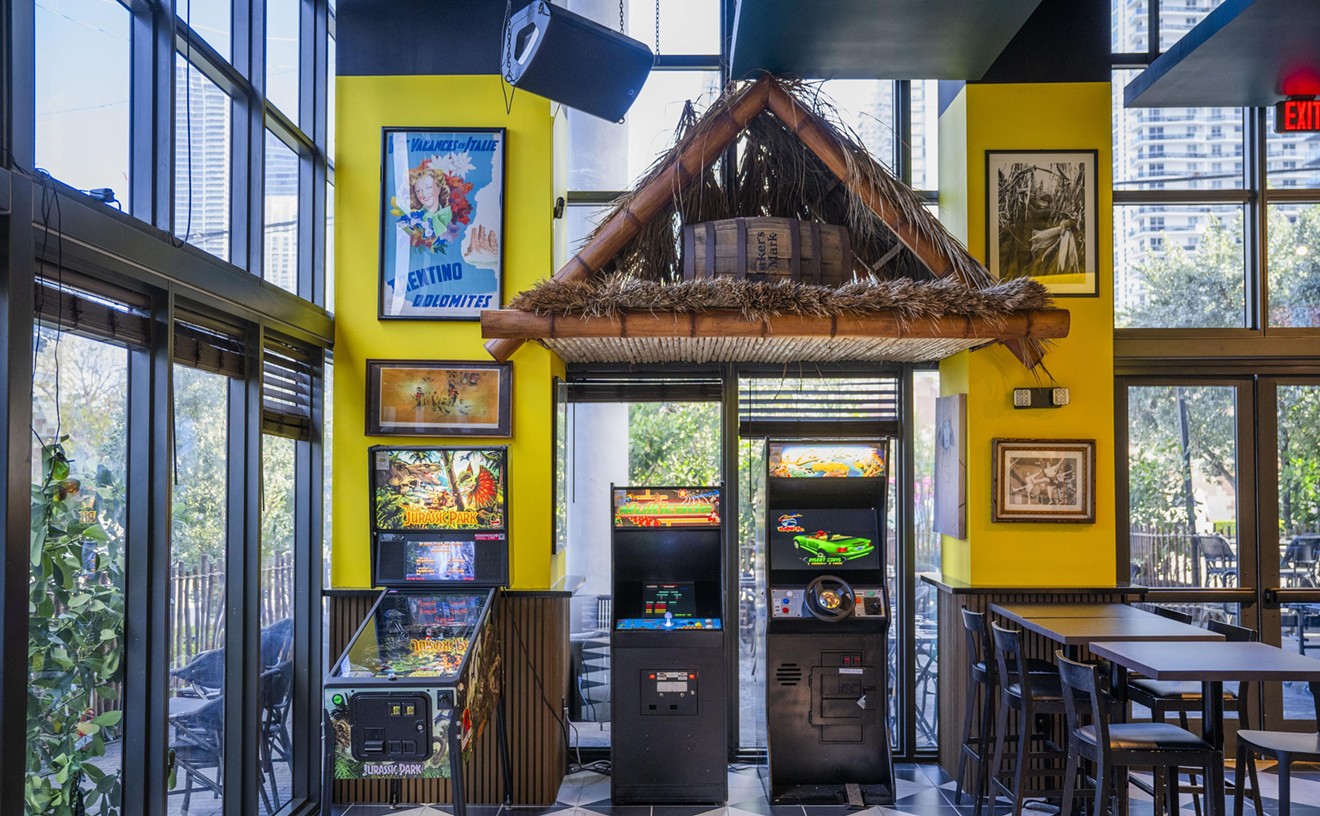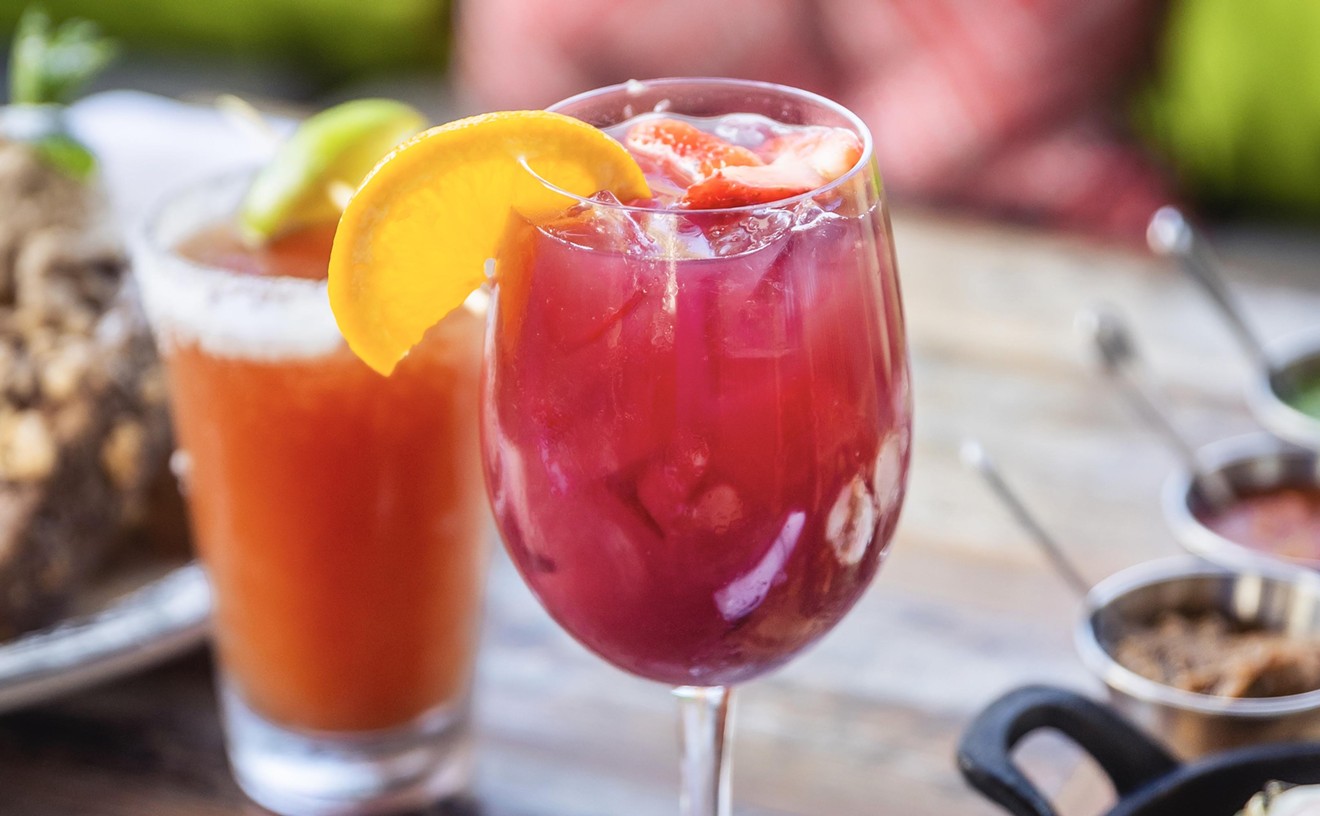In the 1830s African slaves, who had earlier been brought to Jamaica by the British to toil in the sugar cane fields, were emancipated, replaced by what were called "indentured laborers" from India and China. When Chin Sang (Sango) arrived from the latter country in the late Forties, he was able to make a living as a cook in one of the numerous Chinese restaurants that had become popular on the island. His daughter Rosie Hollingshead immigrated to South Florida from Jamaica in 1980, and ten years ago she opened the restaurant that bears her father's name.
Like its strip mall neighbors -- Marie Patties and the Caribbean Delite Restaurant (which specializes in West Indian roti dishes) -- Sango does a huge take-out business. Its main room has been set up to accommodate this take-out trade: a white-tile floor empty save for an ice cream freezer, a flyer-laden table, a yellow-top Formica counter where food and money slide back and forth, and half a dozen chairs lined up against a storefront window.
Don't let the emphasis on take-out deter you from dining in, though; there's a small alcove with mustard-yellow walls off to the side, where bare wooden tables provide seating for sixteen. The same rules apply to eating in as taking out, which means you order at the counter and pick the food up yourself in large Styrofoam containers, which come with plasticware wrapped in a napkin. It's a hefty load to tote to your table, the portions being, as the Rastafarians would say, "I-normous." The prices, I think anyone would say, are more than reasonable, mostly in the six- to eight-dollar range.
A distinct separation between Chinese and Jamaican selections exists at Sango. Printed on one side of the menu are the Chinese dishes, a straightforward recital of Cantonese favorites such as wonton soup, spareribs (which make a spicy and superb starter), and various versions of fried rice, chow mein, and chop suey. Rosie still uses her father's recipes for many dishes, some of which are decidedly different variations on those usually found in Chinese restaurants. One such entree is pork lo mein, with firm, spaghettilike noodles studded with an almost absurd abundance of roast pork nuggets, all of it perked up with a piquant sauce that's flavor-intensive with green peppers, onions, and spices. Sango also serves a roast pork main course: moist, thinly sliced medallions coated with a throat-tingling gravy infused with ginger, garlic, and a mix of Asian spices. But the vegetable egg foo yung is awful: bean sprouts and snow peas enveloped in a thick, oily omelette. The egg foo yung notwithstanding, Sango's Chinese items satisfy on a basic level, but there are numerous places to get better Chinese food -- and few places to get superior Jamaican fare.
Jamaica's original settlers were the Arawak Indians, who sailed to the island 2000 years ago from South America. The Arawaks were adept at fishing, farming, and hunting wild game, and would grill meat and fish on wooden grates called barbacoas, the forerunner of today's jerk pits (and what we call a barbecue pit or grill). Not long after Columbus's arrival in the Bahamas, Jamaica (along with the rest of the Caribbean) was colonized by Spain. The Spanish brought with them tamarinds, ginger, citrus, plantains, coconuts, sugar, bananas, and the concept of frying foods. They also exploited and enslaved the Arawaks, most of whom died as a result of war or disease. Africans were imported as replacement slaves, and they too contributed to Jamaica's developing "fusion" cuisine, introducing beans, pigeon peas, yams, okra, taro, and callaloo (also referred to as taro leaves) to the island.
Eventually Britain challenged Spain's supremacy in the Caribbean, with the English taking control of Jamaica in 1655. (The Jamaicans gained self-rule in 1944, complete independence in 1962.) Very likely the British contributed their unique culinary sensibilities; I'm not certain how the islanders reacted to shepherd's pie and puddings, but they enthusiastically adopted the breadfruit, black pepper, and mangoes that eighteenth-century British traders brought from the South Pacific. They especially took to the ackee fruit, introduced to Jamaicans by Captain Bligh, and they are still the only people in the Caribbean to eat it. (Perhaps this stems from the ackee's poisonous potential if ingested when underripe.) Its pear-shape scarlet pod bursts open when ripe. Cooked ackee has the bland texture, color, and flavor of scrambled eggs and is eaten in Jamaica primarily as a breakfast food. African slaves combined the fruit with salted fish (which, in accordance with British rule, was given to them at least once a year) to create what would become the Jamaican national dish: ackee and codfish.
Ackee and codfish may be the national dish, but to much of the outside world jerk is considered the signature cuisine of the island. Its origin can be traced to the Seventeenth Century, when French pirates supplemented their primary source of income (looting Spanish ships on their way through the West Indies) by capturing wild pigs on Caribbean islands, curing pork on large barbecue frames, and selling it to other ships -- presumably the ones they weren't pillaging. The French freebooters were called boucaniers, from the term boucaner, meaning to cure meat. The cured meat was dubbed jerk. The word buccaneer nowadays refers to a pirate, not purveying pork, and jerk no longer indicates the cured meat but rather the assemblage of assertive ingredients that make up the spice rub itself. Jerks can be wet, dry, or the guy who lives next door, but the first two examples always share the same core seasonings: scallions, intensely flavored English thyme, fiery and fruity Scotch bonnet peppers, nutmeg, cinnamon, pepper, coriander, ginger root, and Jamaican pimento (a potent allspice).
The most famous places to partake of jerked pork and chicken are at the pits of street vendors in Jamaica's Boston Bay, located near the city of Port Antonio. Closer to home you can get some at Sango, on Wednesday, that is, as most of the entrees here are featured as rotating daily specials. Monday, for instance, is cow-foot day; red bean soup is served on Tuesday; and one of Thursday's treats is stewed peas. While this system may prove frustrating if you have driven to Sango in a jerk mood but get there on a nonjerk day, it's actually a good way to ensure that the meals are freshly cooked. Sango's jerked pork is exceptional, its thick chunks of slowly cooked meat punched up with pungent spices. It's hard to believe that these very same ingredients were once used solely to preserve meats, not flavor them. I've never been to Jamaica, but I have sampled a fair number of jerks. Sango's is easily the best I've had.
On Wednesday Sango also serves pepper pot soup, similar in taste to spinach soup -- not surprising, given that it's made with the spinachlike callaloo leaf. Large-cut chunks of yam, cho-cho (chayote squash), and stewed beef, along with a very dense dumpling, lend a heartiness to the broth. Monday's beef soup with pumpkin is really pumpkin soup with beef; like pepper pot, it's an Arawak concoction. It has a smooth consistency, soothing spices, and starchy ingredients like those in stews.
Sango's version of ackee and codfish doesn't deviate from the original. The creamy fruit is scrambled with salted cod, tomatoes, onions, scallions, and peppers. Once you get over the initial foreignness of the ackee, it's quite tasty and surprisingly satisfying. Sango serves it with a bland boiled banana, a sweet and starchy yellow yam, and a dumpling of density similar to -- but of a different shape than -- the one in the pepper pot soup.
Another staple of the Jamaican diet is escovitch, which derives from the Spanish method of pickling cooked fish called escabeche. Islanders prepare it by first frying the fish, then marinating it in vinegar, onions, carrots, and Scotch bonnet peppers. Like jerk, escovitch started out as a means of preservation, though you would never know this from Sango's version; they don't so much marinate the fried fish (kingfish or snapper, depending on availability) as dress it in marinade right before serving. This eliminates the pickling potential of the vinegar but produces a hotter, crisper fillet than the original recipe. The dressing is plenty potent, even as a last-minute addition. Fish escovitch is served only as a main course. (No Jamaican appetizers are available at Sango. You can, however, order a starter of chicken wings escovitch from the Chinese side of the menu.)
In addition to the jerked pork mentioned earlier, Sango serves several other Jamaican meat entrees: Tender oxtail discs with lima beans in a deep, beef-based sauce; a giant breast of succulent roast chicken in a dark brown sauce; chicken stew -- hacked pieces of moist bird in yet another robust brown sauce, this one fortified with garlic and the cooking liquid of beans; and curried goat, aswirl in a muddy green sauce so potently flavored as to make the goat indistinguishable in taste from tender braised beef. This delectably piquant goat stew was the hit of the night at our table.
While the soups here are strewn with stewed vegetables, the stews themselves contain only a stray scallion or random potato. They are, however, accompanied by a choice of white rice or rice and gungo (pigeon) peas, plus two surfboard-shape wedges of fried plantains. An oil and white vinegar-dressed salad of soggy iceberg lettuce and canned corn also comes with dinner (one per person, and one slightly larger serving for two people; I never observed how many salads, or how large a single salad, was presented to a threesome).
I'd like to recommend that you order some of that famous Jamaican Blue Mountain coffee to seal your meal at Sango. I'd like to, but since they don't serve Blue Mountain (or any other coffee) here, I can't. Nor do I suggest a dessert of the gelatinous sweet potato pudding, which is overpowered by allspice. A thick wedge of bread pudding is considerably better, hinting of vanilla, nutmeg, raisins, and rum. For a take-home treat, try the coconut drops: cookie-size confections composed of fresh coconut nuggets, ginger, brown sugar, and nuts.
Sango makes some of its beverages on the premises, like the purportedly aphrodisiacal planter's moss, comprising seaweed, condensed milk, cinnamon, and nutmeg. The rice-pudding flavor is fine, but the consistency is too much like pudding, which I found disconcerting. Carrot juice, with condensed milk and rum, is smoother; ginger beer, a soft drink imported from Jamaica, is the only drink that quenches the thirst and goes well with the food. It's also the only type of beer that you'll find here. Sango doesn't serve alcohol.
If the lack of waitstaff or the thought of eating from Styrofoam is unappealing, an alternative is to visit the second Sango, started up two years ago in Pembroke Pines. This 80-seat restaurant offers the same Jamaican-Chinese menu, generous portions, and popular prices as the Perrine location, plus beer, wine, real plates, and a waitstaff.
Sango Jamaican and Chinese Restaurant
9485 SW 160th St, Perrine; 305-252-0279. Lunch and dinner Monday through Thursday 11:00 a.m. till 9:00 p.m., Friday and Saturday till 9:30 p.m.
Pepper pot soup
$2.75
Curried goat
$5.95
Jerk pork
$5.95
Pork lo mein
$6.00
Bread pudding
$1.
00










